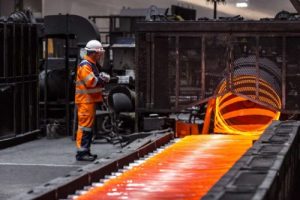Property experts share their passion for ‘unravelling’ historical buildings to make them commercially viable

Two property experts with a passion for “unravelling” historical buildings to “tell their story” and make them commercially viable and usable for the future have shared their insights and passion for the sector.
At the Property Professionals Lunch hosted by TheBusinessDesk.com on Thursday, sponsored by Bevan Brittan, Mark Finch, real estate director at

She described the process as an adventure which “unravelled the story of a building.” She said that it was about making sure that the building’s original story could be told but with the added “mod-cons” and technology to bring a “perfect mix” which brought a building back to life.
McFarlane, whose firm is working alongside Rushbond on the Bretton Hall development at present in Wakefield, added: “But every single one has a challenge. Really I think the biggest challenge is understanding the building and how its evolved over time. Particularly with Breton Hall, it dates back to the 1720s and parts of it were built in the 70s. It is about unpicking that history and how various elements of its development has significance. That is really, really crucial to the development and making it deliverable. We worked with Wakefield Council and it has to meet everyone’s criteria.”
Finch said it was important as a developer to always build a working relationship with architects and contractors from the outset; consulting with the historical societies “so that we’ve really understood how important these buildings are to local communities and the development of architectural style.
“It can be so overwhelming, so I completely understand why some people don’t approach historic buildings. But if you get the right team on board that understands and approaches it with a passion to make it happen, then it can move ahead.
“You have to prepare yourself for the unknown and work with all those stakeholders from the very start.”
Things that might block the development of such buildings include the number of people involved, he said; such as Historic England, local authorities and archaeologists. Finch added that what was important was “how you evolve a consensus of bringing stakeholders together” and “bringing the economics” into the solution.
He said it was important to call in the experts on certain aspects of historical buildings as the Yorkshire marketplace does have the skills. Finch explained: “A lot of people feel ‘we can’t do anything with these buildings’ but there’s a lot of expertise about how you can re-purpose a building within the developer community.”
He added that it was about getting the architectural profession and Local Conservation Officers to work together to 
Mark urged the audience “not to be scared” of taking on such projects and to engage with the statutory bodies.
McFarlane said there were around 21,500 listed buildings across the region, all of which need specific attention. She said that in the past there had been a perception that statutory bodies and stakeholders were not not open to change. “But I think there has been a shift in that – recognising that in order to save these buildings you have to find a solution that works for everyone,” she said.
The duo agreed that there did seem to have been a recent interest in using old buildings again, including a trend in seeing some of them being converted into distilleries or bars.
McFarlane said that there was now more awareness of the impact on providing a sustainable and safe environment. She added: “The richness and depth that brings to a development, I think, is starting to make them more appealing.”
To ensure that developers of such schemes are protected from major risks of working on such schemes where costs could “spiral,” Finch said: “you have a big contingency and you do as much as you can to the survey. The risks have to be balanced.
“Many old buildings are now cool, there’s some fantastic spaces and the challenge is thinking how to re-purpose and re-position them. The experience we’ve had as a company is actually that it’s very difficult to pre sell pre-let any historical building until it’s finished.
“You have to do these things speculatively. It is the long-term future where the value is. It is about making sure that you work with contractors, keep on top of the process as much as you can and survey survey, survey. Build out your revenue and cost modelling.
“Being honest, that that takes a significant amount of time. It is just about being prepared for it to take as long as it needs to, through all of those stages.”
He added that it was exciting to find the right and sustainable use, by not rushing and keeping the buildings “safe and secure” in the meantime.
“But it’ll take as long as it takes to get the right solution because it need to be there for the next 30, 40 50 years. Many buildings so may have been vacant 20 years so another six months isn’t going to hurt as long as you can get the right solution and exit profitably and successfully,” explained Finch.
McFarlane said it was about “trust and openness” through the process. She added: “We’re not here to impose our views on it.”
Finch said: “In this region, with the churches and the cathedrals and the buildings that we have, we do have some expertise, it’s just sometimes developers are a little reticent at times to engage.
“It is also important to have the right skills for the specialist jobs. I don’t think is a particular issue at the moment in terms of craftsmanship and ability within the region. It’s pretty good but where we will be in 10 or 20 years I am not sure. We are getting involved with apprenticeships and training programmes to build up that scale. These are very highly skilled professionals and we need to have the quality people that we currently have.
“The contractors that specialise in that work tend to be relatively small operators.”
McFarlane said conservation architects only accounted for 1.5% of the architectural profession in the region. She is involved in the steering group for conservation on a national level, to help promote the specialist field in which she works.
She said that at Bretton Hall, fire protection was a key element that had to be considered and that also a huge scheme such as it presented lots of details that needed to be adhered to.
“As architects you tend to assume that it will be the same with every module but you have to be really very particular and careful. In Bretton Hall, there were 92 different styles of doors throughout the building and when you look at the scale of complexity it’s really important to understand from the outset.”
Talking of then having a connection with the buildings worked upon, McFarlane said she had worked on restoring on particular building which had now completed, which she was now “going beyond the call of duty” to help the now occupiers develop events programmes to increases the exposure of the building
“It’s really lovely to be part of that story and see how that building has played such an important role in people’s lives.”
Finch said: “There are some buildings have been demolished many years ago that I’m sure we regret as a city today. In the future, I think we will be more in line with a model that integrates and really sees buildings that have been around for generations playing their part in the wider regeneration of the region.”
Finch added: “I think the desire to develop the sort of buildings we are talking about will change as hopefully the legislative process does.”
He called for a simplified way of applying for changes of use, as currently those involved in such projects “have to know exactly what we’re doing at the outset to a listed building consent.”
“It is hard to then to deliver that without building in the flex that’s needed to allow adaptability to different operators who can get it to market to get somebody involved to take it forward.”
Finch said: “I personally have worked for many, many years in the cities and things never been in better shape to attract investment.
“It is about looking at the public realm strategy and not just going for growth for the sake of it. It is about compassion and inclusive growth. There has never probably been a better time for working collaboratively across developers, with investors working for the benefits of the city.”
McFarlane said a number of occupiers to older buildings wanted to use them as vibrant workplaces. She added: “The changes in the office environment over the last few years have been phenomenal. The development of a whole new cultural offer where it’s all about collaboration is enabling people who don’t want to make huge financial commitments to at least have a good starting point as a business to thrive.”
McFarlene also agreed that there needed to be a simplification of the process. She said: “With Bretton Hall in particular, because it’s such a large scale and complex project, the buildings don’t have the flexibility to allow you to develop in a phased manner in the way that the conditions are written.”
Finch said Rushbond’s work on the Leeds Majestic building had got to the stage where the temporary support facade were put in place last year. The firm is looking at how the speculative development could provide workspaces “which are the quality that the city needs to take it on to the next stage.”
Finch added: “We’re also in the process of transforming the Corn Exchange, which is an evolutionary process that probably a third way through. There will be some exciting stuff to announce from the spring on that some of the work.”
McFarlane said that the Bretton Hall project has seen lots of demolition work complete, with the next step to focus on the landscaping and infrastructure “with a view to starting in the summer on site”. She said she was excited to get to this phase as the buildings had created “a bit of a hole in the middle of the park.”
For more information about LCF, TheBusinessDesk.com’s charity partner, watch the charity’s video:








